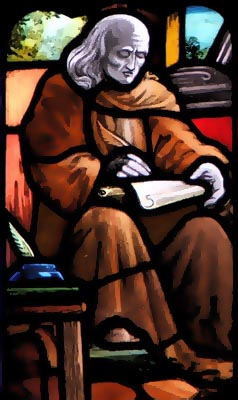 |
 |
|||
|
|
Gildas was born in the Strathclyde or Cwm Cawlwyd area around AD 500. He was one of the many sons of the great Northern King, Caw, who sent him south to study literature under St. Illtud at Llanilltud Fawr (Llantwit Major) and Ynys Byr (Caldy Island). St. Gildas completed his education the great cities of Gaul before finally turning to missionary work in his native lands. Later, he returned to Wales and the district of Pebidiog in Dyfed. Here, he preached to the faithful until, one day, his voice was silenced by the entry of the pregnant St. Non into his church. She was carrying St. Dewi, for whose own sermons, St. Gildas decided, the lands thereabouts must be waiting. (This story seems to have been wrongly attached to Gildas who was actually younger than St. David.) He therefore left for Armagh in Ireland. Unfortunately, while he was away, the long-running dispute, between Gildas' warrior family and the High-King Arthur, came to a head and his eldest brother, Huail, was killed. At first, Gildas could not bring himself to forgive Arthur but, later, St. Cadog persuaded the two to meet at Llancarfan and reconcile their differences. While there, St. Cadog envied a fine bell which Gildas had made for the Pope, but he would not part with it. Proceeding on a pilgrimage to Rome, Gildas found that the bell would no-longer ring, so he decided to give it to Cadog after all. Gildas remained at Llancarfan as an interim-Abbot, overseeing St. Cadog's schools, while the latter travelled North to spread the word of Christ. In return, the Northern saint asked Cadog to found a monastery over the grave of his father, Caw, at Cambuslang. Upon his friend's return, Gildas moved on to Ynys Echni (Flatholm), in the Bristol Channel, where he lived as an island hermit. Cadog lived for a while on Ynys Barren (Barry Island) and the two often met up for prayers. It may have been here that Gildas wrote his famous "De Excidio Britannae" and a, supposedly lost, "Historias de Regibus Brittaniae". In the late 560s, Gildas was recalled to Ireland by the High-King Ainmere and asked to restore the crumbling Irish Church to its former glory. Being harassed by pirates on his little island, Gildas eagerly agreed. Upon his return to Britain, he retired to a little hermitage in Llantokay (Street), near Ynys-Witrin (Glastonbury), in Somerset. Despite his chosen life of solitude, he was often visited for advice and, more than once, became embroiled in the affairs of the nearby Abbey and of the British State. A well-known story is often told of how Melwas, the local King of Glastening, kidnapped the High-Queen Guinevere and Gildas was obliged to step in as mediator and prevent an all-out war. He died at Llantokay (Street) on 29th January AD 570 and was buried in Glastonbury Abbey. He has always been, but should not be, confused with St. Gueltas of Ruys in Brittany. Contemporary writings of St. Gildas exist. He is considered an historic personage.
|
|||
| © Nash Ford Publishing 2001. All Rights Reserved. | ||||





 St. Gildas Badonicus
St. Gildas Badonicus